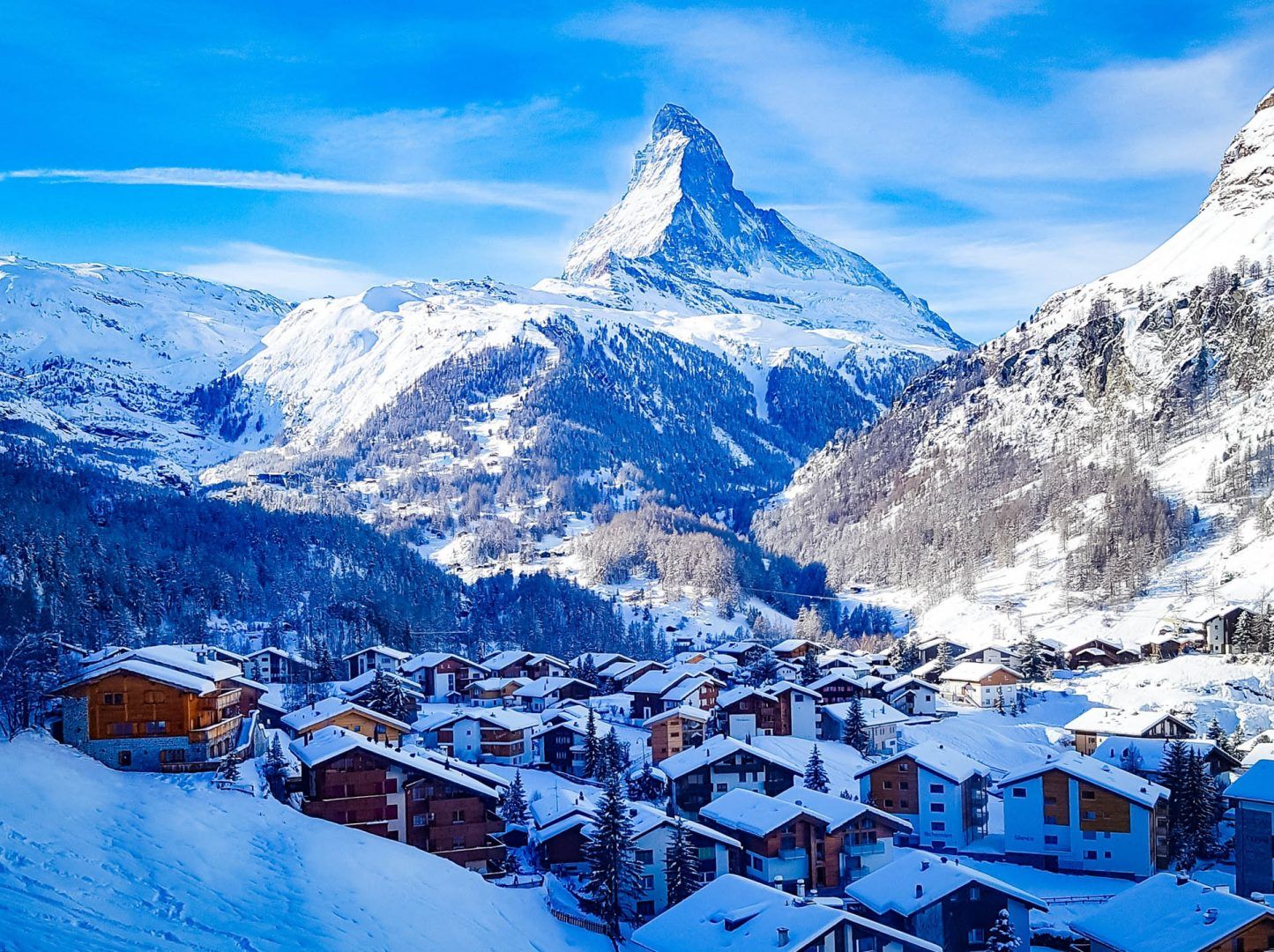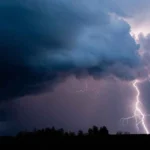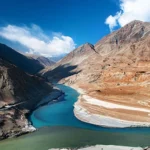
The Swiss Alps, a majestic mountain range renowned for their breathtaking beauty and natural wonders, came into existence approximately 45 million years ago. This dramatic creation was the result of the Alpine orogeny, a complex geological process involving the collision of tectonic plates. Over millions of years, the Earth’s crust was folded, uplifted, and shaped into the magnificent peaks and valleys that we see today.
Spanning an expansive 65,000 square kilometers, the Swiss Alps boast a diverse range of elevations. Towering above the landscape are peaks that soar beyond 4,000 meters (13,000 feet), making them some of the highest in Europe. This vast range of altitudes contributes to the Alps’ ecological diversity, providing a variety of habitats for both flora and fauna.
The Matterhorn, perhaps the most iconic emblem of the Swiss Alps, stands proudly at 4,478 meters (14,692 feet) above sea level. Its pyramid-like shape and formidable presence have captivated mountaineers and adventurers for generations. However, it’s also a mountain that demands the utmost respect, as its challenging ascent has claimed the lives of many climbers over the years.
The north face of the Eiger, known as the “Mordwand” or “Murder Wall” in German, is renowned as one of the most treacherous and technically challenging climbs in the world. Climbers face extreme exposure to the elements, unpredictable weather, and sheer vertical rock walls, making it a daunting prospect even for the most experienced mountaineers.
With an astounding count of over 82 summits exceeding 4,000 meters in height, the Swiss Alps offer an unparalleled playground for climbers and hikers. These towering peaks not only present thrilling challenges but also provide breathtaking panoramic views of the surrounding landscapes.
The Swiss Alps are adorned with approximately 1,800 glaciers, spanning an area of about 1,080 square kilometers (420 square miles). These frozen rivers of ice have been sculpting the landscape for millennia, carving out valleys and leaving behind stunning ice formations.
Encompassing a network of over 65,000 kilometers (40,389 miles) of hiking trails, the Swiss Alps offer an endless array of routes for outdoor enthusiasts. Whether you’re a seasoned hiker or a leisurely stroller, these paths wind through meadows, forests, and high-altitude vistas, inviting all to explore the natural wonders of the region.
Switzerland’s reputation as a winter wonderland is reinforced by its more than 200 ski resorts. These alpine havens attract snow sports enthusiasts from around the globe with their well-groomed slopes, challenging off-piste terrain, and cozy chalets for après-ski relaxation.
The historic first ascent of the Matterhorn took place in 1865 when a British expedition led by Edward Whymper reached its summit. This achievement marked a pivotal moment in the history of mountaineering, although it was marred by tragedy when four members of the team perished during the descent.
Climbing to an astonishing 3,454 meters (11,332 feet) above sea level, the Jungfrau Railway terminates at Jungfraujoch, often referred to as the “Top of Europe.” It’s not just a testament to engineering prowess but also offers visitors the chance to experience the extraordinary high-altitude environment, complete with sweeping views of glaciers and peaks.
Monte Rosa, the highest mountain in Switzerland and the second-highest in the Alps, stands at an imposing 4,634 meters (15,203 feet). Its distinctive pyramidal shape and glaciated slopes make it a prominent feature of the Pennine Alps. The summit offers breathtaking vistas of the surrounding peaks and glaciers, attracting mountaineers and nature enthusiasts seeking the ultimate alpine experience.
Established in 1914, the Swiss National Park is a testament to Switzerland’s commitment to preserving its natural heritage. Covering an area of 67,590 acres, it’s the country’s only national park. Here, visitors can explore pristine wilderness, observe diverse wildlife, and appreciate the unspoiled beauty of the Alps.
The Aletsch Glacier, stretching for about 23 kilometers (14 miles), is not only the largest glacier in the Alps but also a UNESCO World Heritage site. This colossal river of ice winds its way through the Bernese Alps, offering a stark reminder of the region’s glacial history.
The Eiger Trail is an iconic hiking route that runs along the base of the Eiger’s north face. This captivating trail provides hikers with a unique perspective of the mountain’s towering walls and is an excellent way to appreciate the grandeur and challenges associated with Eiger’s ascent.
The Swiss Alps have a storied history of mountain guiding, with legendary figures like Ulrich Inderbinen, who holds the record for summiting the Matterhorn more than 370 times. These guides play a pivotal role in ensuring the safety and success of climbers and mountaineers in the region.
In 1858, Charles Barrington, Christian Almer, and Peter Bohren achieved the first successful ascent of the Eiger. This marked a crucial milestone in the history of alpinism, setting the stage for future climbers to tackle this formidable peak.
Switzerland faces a significant risk of avalanches due to its mountainous terrain and heavy snowfall. To mitigate this danger, extensive measures are employed, including avalanche barriers, controlled releases, and monitoring systems. These efforts are essential for protecting both residents and tourists.
The Swiss Alpine Club, founded in 1863, has been a driving force behind the promotion of alpinism, mountain conservation, and safety in the Swiss Alps. It serves as a hub for mountaineers and climbers, offering resources, support, and a community of like-minded individuals.
Switzerland is equipped with a highly skilled mountain rescue service known as REGA (Swiss Air-Rescue). This vital organization responds swiftly to emergencies in the Alps, conducting daring helicopter rescues and saving countless lives in the process.
The Swiss Alps boast an extensive network of climbing routes, numbering over 1,000. Climbers of all skill levels can find routes that suit their abilities, from beginner-friendly ascents to challenging and technical climbs. Each route presents a unique set of challenges and rewards, making the Swiss Alps a magnet for climbers from across the globe.
Switzerland boasts several high-altitude villages, where residents live amidst stunning mountain landscapes. Juf, located in the canton of Graubünden, holds the distinction of being the highest permanently inhabited village in Europe at 2,126 meters (6,975 feet). These villages often offer a tranquil, picturesque way of life, deeply connected to the surrounding natural environment.
The Swiss Alps are adorned with numerous glacial lakes, each with its unique charm and character. Lake Geneva, one of the most extensive, stretches along the border between Switzerland and France. Lake Lucerne, surrounded by towering peaks, is another jewel. These lakes not only provide opportunities for recreation but also serve as essential freshwater sources for the region.
The Swiss Alps attract millions of visitors each year, making tourism a significant contributor to the Swiss economy. During the summer, hikers explore the vast network of trails, while in the winter, skiers and snowboarders flock to world-class resorts. The Alps offer a myriad of outdoor activities, making it a year-round destination.
The Swiss Alps are home to a diverse range of flora and fauna, adapted to the harsh alpine environment. Ibex, chamois, marmots, and golden eagles are among the iconic wildlife species. Alpine flowers like edelweiss and gentians add vibrant colors to the landscape, thriving in the meadows and rocky slopes.
The Swiss Alps display a remarkable geological diversity, offering a treasure trove of geological features. Various rock types, including limestone, granite, schist, and more, shape the terrain. These geological formations have played a pivotal role in creating the Alps’ diverse landscapes, from jagged peaks to deep valleys and dramatic cliffs.









